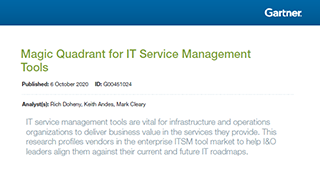IT service organizations have been on the forefront of modern technology for decades, so they are no strangers to working in a complex and ever-evolving world. The rate at which technology advances continues to increase with no signs of slowing in the future. Maintaining pace with the breakneck speed of technology is the only option for IT organizations that want to remain relevant in today’s business world.
While speed of production and delivery is imperative, speed alone will not provide success. IT management must also ensure the quality of the product. As such, the Information Technology Infrastructure Library (ITIL) was created to help guide organizations in the successful development of IT products and services.
What is ITIL?
In short, ITIL is a set of guidelines and best practices for how an IT organization can provide the best service possible. The instructions provided by ITIL are intentionally generalized so that all IT organizations can apply the fundamentals of the system to their development systems. ITIL is intended to be customized and implemented into your organization’s unique business structure.
ITIL has been tested and improved upon since its original inception over the past few decades to help organizations approach IT service management in an efficient and optimized way for providing their customers with what they need. Changes have been made to ITIL to continually incorporate new methodologies that are found to be effective means for improving IT services.
Most recently, ITIL 4 was created which advises the implementation of systems like Agile, Lean, and DevOps that were created with the singular goal of increasing delivery speed while maintaining service and improving the quality of deliverables. ITIL provides a fantastic outline for structuring your IT organization and services in a way that is conducive to success.
While its generalized nature makes it applicable to all kinds of IT organizations, it also means you must decide which parts of ITIL are best for your specific business. You should consider aligning your IT services with your business needs in the manner which ITIL recommends. One of the best methods for implementing ITIL concepts into your organization is through the implementation of integrated service management.
What is Integrated Service Management (ISM)?
Based on the ITIL framework, integrated service management is a trimmed down and easily implementable IT management methodology. Integrated service management was created to give organizations a standardized method for implementing ITIL concepts quickly and easily. Integrated service management is essentially a leaned down version of ITIL, utilizing the teachings of ITIL while cutting out the unnecessary bulk.
Unlike ITIL, integrated service management focuses on six core processes that are compatible with all IT service management processes throughout the IT service lifecycle. These core processes are:
Service Level Management
Service level management (SLM) involves the definition of services, the levels of services required to support business processes, and the service level agreements (SLAs) created to establish standards for successful operation. SLM activities involve identifying business requirements, translating business requirements into IT requirements, and performing analyses of the gaps between business requirements and available services.
Change Management
Change management guides the adoption of changes by preparing, implementing, and supporting the change process to drive organizational success. Change is a difficult time for many and change management seeks to offer a structured approach for creating widespread adoption and implementation of new IT services and processes. One of the primary duties involved in change management is education regarding changes to ensure everyone is on the same page before the switch is flipped.
Operations Management
Operations management is geared towards empowering organizations to meet the highest levels of optimization possible. It focuses on the most efficient usage of resources such as labor and services to maximize profit for the organization. Operations management teams seek to balance cost and revenue to increase the performance of IT services. Operations managers are responsible for finding any and all avenues for improving performance to cost ratios.
Incident Management
Incident management seeks to ensure business operations go as smoothly as possible. An incident manager is responsible for the process of handling user issues as quickly and efficiently as possible. Incident management involves logging, classification, prioritization, diagnosis, and resolution of incidents. It is essential that incident occurrences are infrequent and solved as rapidly as possible.
Configuration Management
Configuration management involves the planning and management of services across an organization’s infrastructure. It tracks the configurations and relationships between the components of your various IT services. Configuration management ensures the IT assets required to deliver services are controlled and properly detailed for use throughout the organization.
Quality Management
Quality management is responsible for ensuring that all activities and tasks are performed at the desired level of excellence. The quality manager’s duties involve planning, quality assurance, quality control, and improvement. The quality of IT services must be maintained at all times for the organization to continue successful operations. As such, the quality management team plays a pivotal role in daily operations.
Integrated service management combines the best practices for these six core components of ITIL to provide organizations with a clear and concise framework for successful IT service operations. Businesses looking to provide excellent service must always be seeking ways to improve upon their own operations. Integrated service management offers the recipe needed to find this success.
One of the key components for integrated service management is the application of automation throughout the entire organization. As recommended by ITIL 4, continued adoption of automation, especially for operations that occur on a large scale and regular basis, is one of the key ways for increasing IT service delivery speeds and quality.
Integrated service management tools make use of automation to reduce man hours spent on repetitive tasks, freeing up IT professionals to focus on innovation instead. Leveraging integrated service management best practices combined with automation techniques will drastically improve your organization’s capability of providing quality IT services and solutions.







